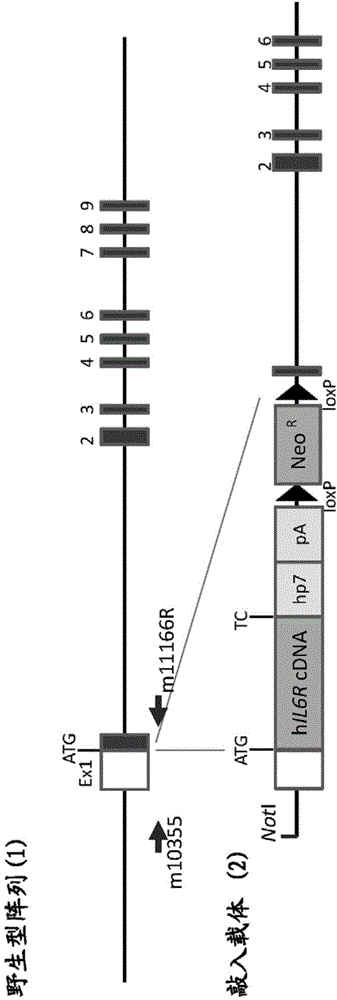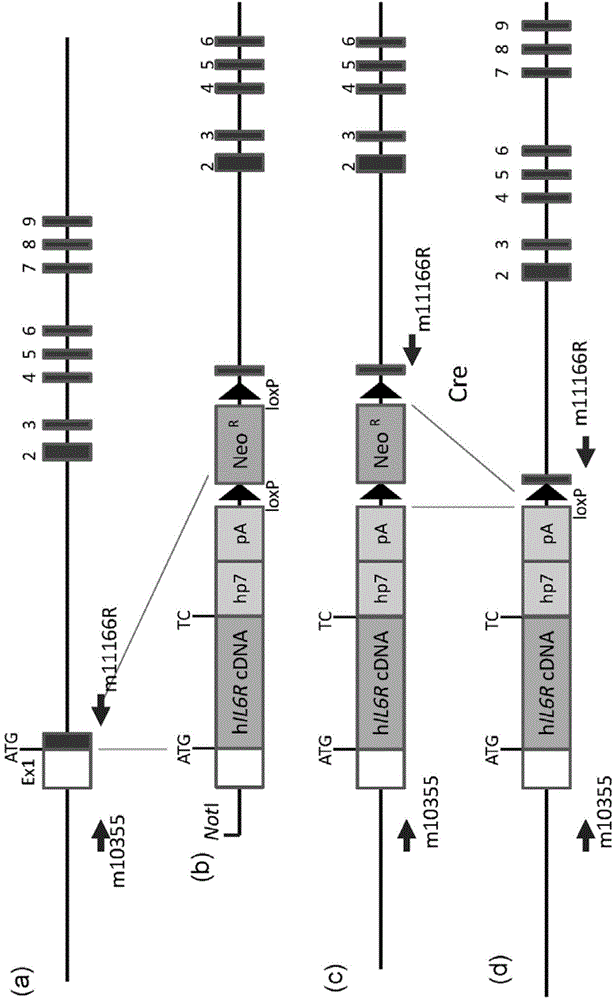Gene knock-in non-human animal
A non-human animal and genetic technology, applied in the direction of anti-animal/human immunoglobulin, drug combination, biological testing, etc., can solve the problem of weak effect
- Summary
- Abstract
- Description
- Claims
- Application Information
AI Technical Summary
Problems solved by technology
Method used
Image
Examples
Embodiment 1
[0104] [Example 1] Preparation of human IL6R gene knock-in mice
[0105] (1) Construction of knock-in vector
[0106] The E. coli artificial chromosome (BAC) cloned with the genomic region of the mouse interleukin-6 gene (I16ra) was used. The target region of the mouse Il6ra gene on the BAC uses the Red / ET system (GeneBridges) to insert the coding sequence of the human interleukin-6 receptor gene (GeneBank#NM000565), hp7 sequence, and poly A addition signal through homologous recombination , LoxP sequence, neomycin resistance (neo) gene cassette and loxP are connected in sequence. At this time, insert the translation initiation site of exon 1 of the mouse Il6ra gene on the BAC so that it coincides with the translation initiation site of the human IL6R gene, and make the exon of the mouse Il6ra gene 1 The base sequence defect after the translation start site inside is equivalent to 40 base pairs. In addition, the pgk gene promoter is added to neo, which is a drug resistance gene,...
Embodiment 2
[0128] [Example 2] Establishment and evaluation of humanized giant lymph node hyperplasia model mice
[0129] (1) Establishment of humanized giant lymph node hyperplasia model mice
[0130] The hIL6R knock-in mice were bred with H-2Ld human IL6 transgenic mice (Cytokine. 2002, Dec. 21; 20(6): 304-311) to make double transgenic mice. The genotype was analyzed by PCR using genomic DNA extracted from the tissue of each individual, and individuals with a homozygous hIL6R knock-in array and hIL6 transgene were selected. The detection of hIL6R knock-in array uses the above-mentioned PCR reaction system. That is, the PCR reaction solution consisted of 1 μl of sample, 12.5 μl of 2×GC buffer I, 4 μl of dNTP (2.5 mM), 0.25 μl of primers (50 μM each), 0.25 μl of LA Taq (TAKARA), and 6.75 μl of distilled water (25 μl in total) ). In addition, PCR conditions were a preheating at 94°C for 4 minutes, 35 cycles of amplification cycles at 94°C for 30 seconds, 62°C for 30 seconds, and 72°C for 3 ...
Embodiment 3
[0146] [Example 3] Knock-in of neomycin resistance gene into mouse Pou5f1 locus
[0147] (1) Construction of knock-in vector
[0148] The neomycin resistance (neo) gene was inserted so that the translation initiation site of exon 1 of the mouse Pou5f1 gene coincides with the translation initiation site of the neomycin resistance (neo) gene, Furthermore, the base sequence defect after the translation initiation site inside exon 1 of the mouse Pou5f1 gene was equivalent to 107 base pairs to construct a knock-in vector. At this time, construct the hp7pA vector with the hp7 sequence and the poly A addition signal immediately below the stop codon of the neo gene, and the hp7 pA vector without the hp7 sequence and the poly A addition signal, but the endogenous poly A addition signal The control vector. In addition, as the homology arm of the knock-in vector, a structure of 1.7 kb upstream of the genomic DNA reaching the translation initiation site of the Pou5f1 gene and about 5 kb geno...
PUM
 Login to View More
Login to View More Abstract
Description
Claims
Application Information
 Login to View More
Login to View More - R&D Engineer
- R&D Manager
- IP Professional
- Industry Leading Data Capabilities
- Powerful AI technology
- Patent DNA Extraction
Browse by: Latest US Patents, China's latest patents, Technical Efficacy Thesaurus, Application Domain, Technology Topic, Popular Technical Reports.
© 2024 PatSnap. All rights reserved.Legal|Privacy policy|Modern Slavery Act Transparency Statement|Sitemap|About US| Contact US: help@patsnap.com










